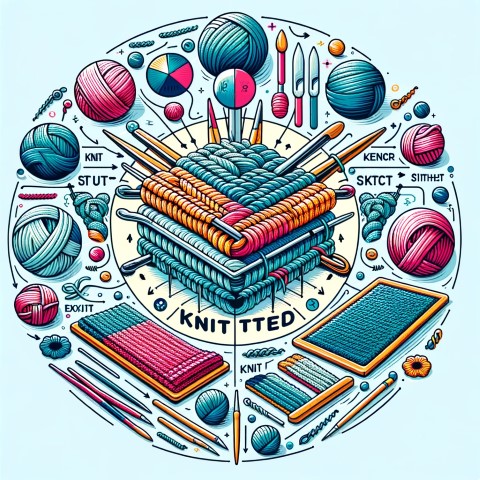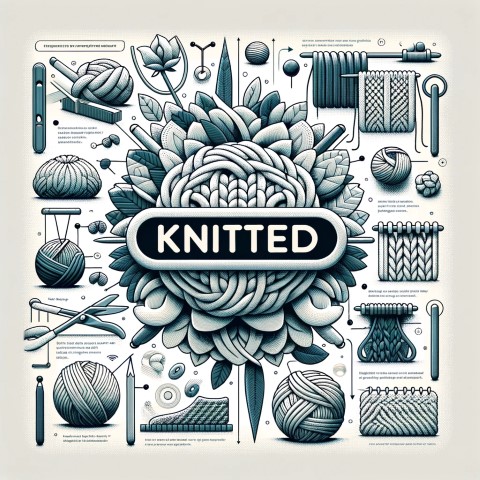Last Updated on: 13-Mar-2024 (4 months, 14 days ago)
Share on Facebook • Share on Twitter
Knit Textiles: Revolutionizing Fashion and Functional Fabric Solutions
Unraveling the World of Knit in Textiles
Welcome to the fascinating world of knit textiles, where threads intertwine to create intricate and versatile fabrics. Knitting is a fabric construction technique that has been used for centuries to produce a wide range of textiles, from cozy sweaters to durable athletic wear.
Knit fabrics are characterized by their unique stretchability, breathability, and texture, making them ideal for a variety of applications in the textile industry. Whether you're looking for comfort, flexibility, or style, knit textiles offer endless possibilities.
In this article, we will delve deep into the art and science of knitting, exploring its rich history, innovative techniques, and diverse applications. From the ancient origins of knitting to the latest advancements in knitting technology, we will uncover the secrets behind this timeless fabric construction method.
Join us on a journey through the world of knit textiles as we unravel the intricacies of this fascinating craft and discover the endless possibilities it offers in the realm of fashion, sportswear, and beyond.
History and Types of Knit Textiles
Knitting has a rich history dating back to ancient times. It originated in the Middle East and spread to Europe during the Middle Ages. Initially, knitting was done by hand using needles, but with the advent of industrialization, knitting machines were developed, revolutionizing the textile industry.
- 1. Warp Knit: Warp knitting involves interlocking loops in a vertical direction, resulting in a stable and durable fabric. Common examples include tricot and raschel knits.
- 2. Weft Knit: Weft knitting creates loops in a horizontal direction, making the fabric stretchier and more flexible. Examples include jersey, rib, and interlock knits.
- 3. Circular Knit: Circular knitting is done on machines with continuous tubes of needles, producing seamless fabrics ideal for garments like socks and T-shirts.
- 4. Flat Knit: Flat knitting involves knitting back and forth in rows on straight needles, commonly used for producing panels and pieces for garments.
- 5. Jacquard Knit: Jacquard knitting allows for intricate patterns and designs to be knitted directly into the fabric, offering endless creative possibilities.
Tips for Handling Knit Textiles:
- 1. Use the Right Needle: Choose needles appropriate for the type of knit fabric to prevent snagging or stretching.
- 2. Handle with Care: Knit fabrics can be delicate, so avoid rough handling to prevent damage to the fabric.
- 3. Follow Care Instructions: Pay attention to washing and drying instructions to maintain the integrity and shape of the knit fabric.
- 4. Store Properly: Fold knit garments neatly to avoid stretching or misshaping, and store them in a cool, dry place away from direct sunlight.
- 5. Seam Allowances: When sewing knit fabrics, use a stretch stitch and allow for seam allowances that accommodate the fabric's stretch.
Knit textiles are incredibly versatile and find applications across various industries due to their unique properties such as flexibility, stretchability, and breathability. Here are some of the key applications of knit fabrics:
- 1. Apparel: Knit fabrics are widely used in apparel manufacturing for making garments such as T-shirts, dresses, leggings, and sweaters. Their stretchability and comfortable fit make them ideal for everyday wear.
- 2. Sportswear: Knit textiles are popular in sportswear due to their ability to wick moisture away from the body and provide freedom of movement. They are used in making activewear, athletic jerseys, and compression garments.
- 3. Home Textiles: Knit fabrics are used in home textiles for making bedding, blankets, pillows, and upholstery fabrics. Their softness and warmth make them suitable for creating cozy home furnishings.
- 4. Medical Textiles: Knit textiles find applications in the medical field for making compression garments, bandages, surgical gowns, and wound dressings. Their stretchability and breathability aid in patient comfort and mobility.
- 5. Automotive Textiles: Knit fabrics are used in the automotive industry for making seat covers, headliners, and interior trims. Their durability and flexibility make them suitable for withstanding the rigors of automotive use.
Profiles of Major Manufacturers and Users of Knit Textiles
- Nike: Nike is a global leader in athletic footwear and apparel, utilizing knit textiles in their innovative Flyknit technology for lightweight and breathable sneakers.
- Adidas: Adidas incorporates knit textiles in their Primeknit series, offering seamless and comfortable footwear and clothing options for athletes and casual wearers alike.
- Lululemon: Lululemon uses knit fabrics in their activewear lines, known for their moisture-wicking properties and stretchability, providing optimal performance during workouts.
- Zara: Zara, a renowned fashion retailer, features knit textiles in their trendy and comfortable knitwear collections, catering to fashion-forward consumers worldwide.
- H&M: H&M utilizes knit textiles in their diverse range of clothing offerings, including sweaters, dresses, and loungewear, providing stylish and affordable options for fashion enthusiasts.
Conclusion: The Significance of Knit Textiles
In summary, knit textiles play a vital role in the modern textile industry, offering a plethora of benefits across various applications. From sportswear to home textiles, knit fabrics have revolutionized the way we perceive comfort, performance, and style.
The versatility of knit textiles allows for endless creativity in design and functionality. Whether it's the seamless construction of athletic apparel or the intricate patterns of fashion garments, knit fabrics provide designers with unparalleled freedom to innovate.
Additionally, the advancements in technology have led to the development of high-performance knit fabrics that offer superior moisture management, breathability, and durability. This has not only enhanced the performance of athletic wear but has also expanded the use of knit textiles in medical, automotive, and other specialized industries.
As we move forward, it's evident that knit textiles will continue to shape the future of the textile industry. With sustainable practices and innovative technologies driving the industry forward, we can expect to see even more exciting developments in the world of knit fabrics.
In conclusion, knit textiles are not just fabrics; they are a testament to human ingenuity, creativity, and adaptability. Their significance in the textile industry cannot be overstated, and their impact will continue to be felt for generations to come.
Fabrics made from only one set of yarns, all running in the same direction. Some knits have their yarns running along the length of the fabric, while others have their yarns running across the width of the fabric. Knit fabrics are held together by looping the yarns around each other.
Some more terms:
Canvas Unleashed: Unraveling the Artistry and Allure of this Textile Wonder
Cotton, linen, or synthetic fabric made with an even weave in heavy and firm weights for sails and industrial purposes. Awning strips canvas has painted or woven stripes on cotton duck. Cross-stitch...
Read about CanvasPyrenees
A wool fabric made in France from the wool of Pyrenees? flocks of sheep. The Pyrenees are a mountain chain between France and Spain. The fabric is well known because it is a high quality fabric which...
Read about PyreneesLinters
Linters are the short fibers left on the cotton seed after the longer fibers have been removed. Although the fibers are too short for spinning or cloth making, they are useful in paper pulp. The...
Read about LintersNatural Vegetable Fibers: Harnessing Plant Power for Textiles
Natural Vegetable Fibers: The Cradle of Textile ManufacturingThe Origins and History of Natural Vegetable FibersNatural vegetable fibers, a pivotal material in textile manufacturing, have a history...
Read about Natural Vegetable FibersWindsor chair
General term for a chair with a wooden seat and separate leg assembly and spindle back. Originated in the 17 century around Windsor, England and also popular in America. For other types of chairs,...
Read about Windsor chairCashmere: The Luxurious Fiber Transcending Time
A Touch of Elegance: Unveiling the Exquisite World of CashmereIntroductionCashmere, the epitome of luxury in the textile industry, is a fiber that has captivated the hearts of connoisseurs for...
Read about CashmereMonotone
In the realm of textiles, the term "Monotone" refers to a color scheme or design element characterized by the use of a single color or shades and tones of a single hue. It is a design concept that...
Read about MonotoneBroken Pick
The term "Broken Pick" is commonly used in the textile industry to describe a specific type of defect that occurs during the weaving process. When a broken pick occurs, it means that the weft yarn,...
Read about Broken PickOn this page
Add a definition
- The term you want to define
- Its definition in 500 words or less
- Attach an image if necessary.
- Optionally, tell us about yourself in 200 words or less!
Companies for Knit:
- Company name
- Company address
- Attach a logo, if necessary.
- Optionally, tell us about yourself in 200 words or less!

 Fashion designer Victoria Beckham launched her fashion label after her music career with the Spice Girls.
Fashion designer Victoria Beckham launched her fashion label after her music career with the Spice Girls.

